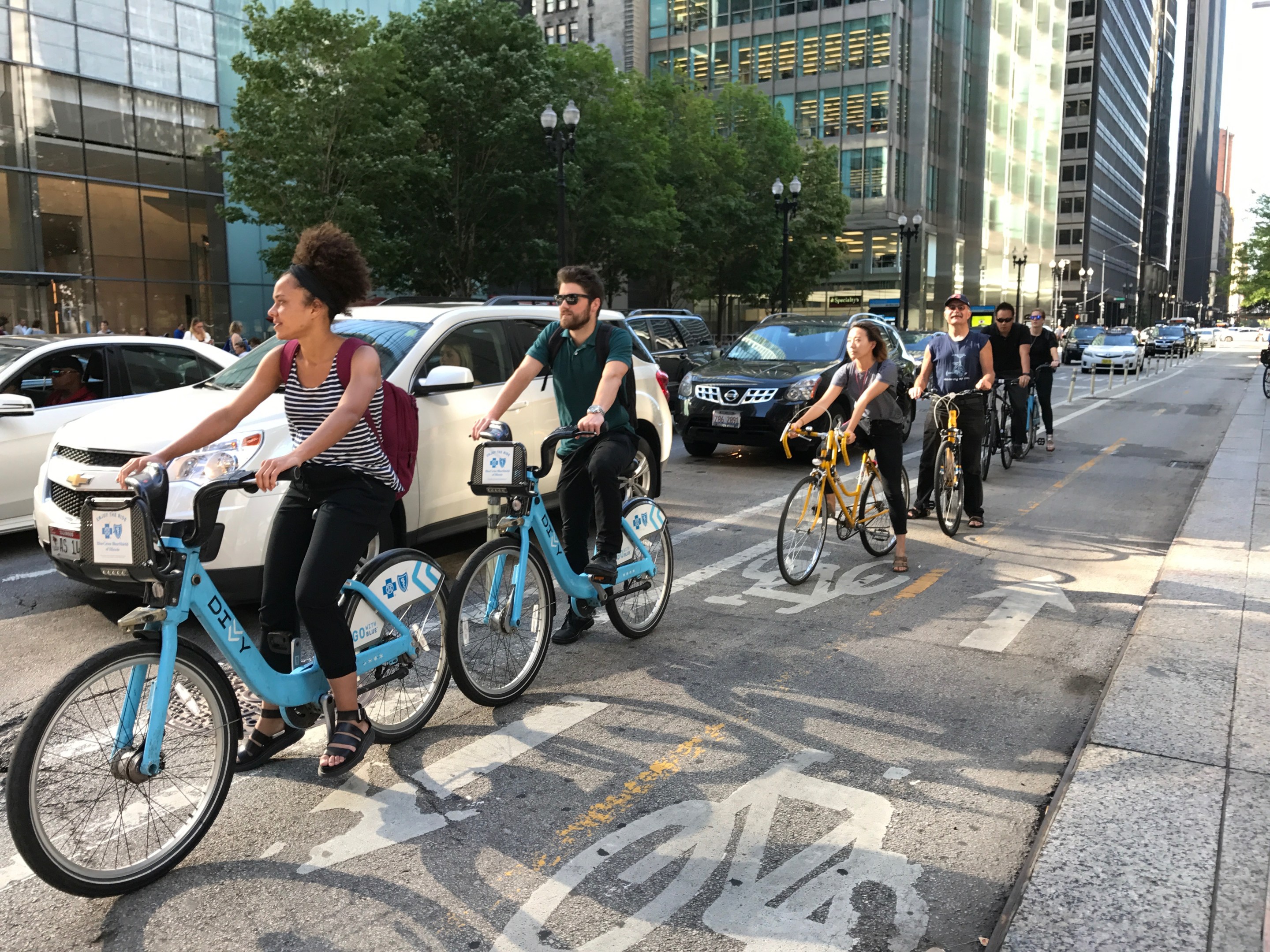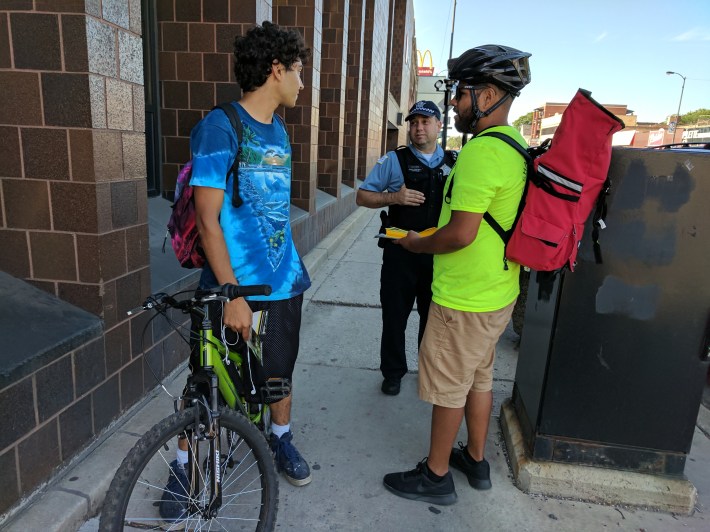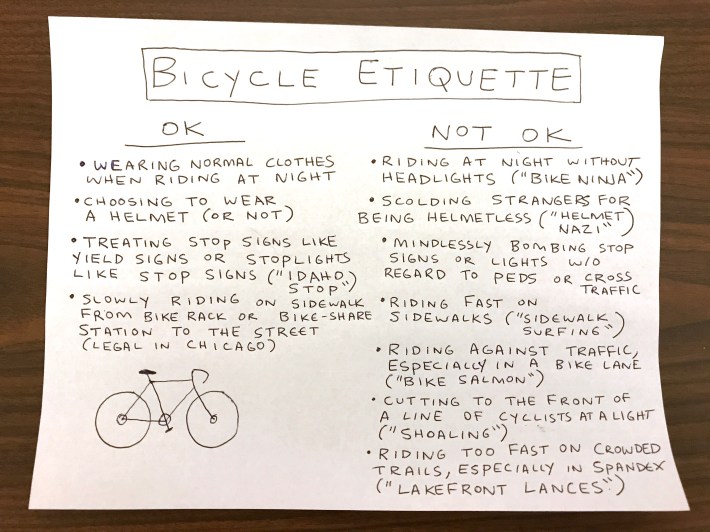Bad Biking Behavior, and the Best Ways to Prevent It
12:41 PM CDT on August 3, 2017

Bike riders line up at the light at Dearborn/Madison. Cutting in line is known as “shoaling.” Photo: John Greenfield
[The Chicago Reader publishes a weekly transportation column written by Streetsblog Chicago editor John Greenfield. We syndicate the column on Streetsblog after it comes out online.]
One of the main reasons biking is my favorite way to get around Chicago is the good vibes. Cyclists can bypass hectic, sun-baked arterials during hot-weather rush hours in favor of tranquil, leafy backstreet routes. And nothing beats a relaxed cruise home, past buzzing neon and packed sidewalk cafes on an absolutely perfect summer night.
While friction between cyclists and motorists is widely publicized, I have plenty of positive interactions with those around me when I'm in the saddle: the driver who waves me through a four-way stop, the pedestrians who wave thanks after I stop and nod for them to cross the street. Most of my exchanges with other people on bikes are similarly pleasant—after all, we've got something in common.
But cyclists still get on each other's nerves sometimes, as a recent discussion on the Chainlink, a local social networking site, made abundantly clear. Chainlink president Yasmeen Schuller started a thread called "Pet Peeves Among the Pedals" and invited members to talk about annoying and dangerous bicyclist behavior they hate. She started with one of her own beefs, "the cyclist that blows past me so close to me I feel the wind of their SWOOOOOSH as they fly past, but they say nothing to warn me. . . . Buy a bell and/or tell me you are there!"
Some of the other practices cyclists railed against are annoying breaches of etiquette like "shoaling." This term, coined by influential blogger Bike Snob NYC, refers to when a large group of bike commuters is stopped at a light and someone rolls up from behind and rudely cuts in front of the pack to get a head start.
Particularly irksome is sexist "man-shoaling," noted member Heléna Klumpp, "by guys who assume they're faster than me—you know, because they're guys, so they must be." Kate M. added that it's satisfying to loudly yell "On your left!" when passing these cads after the light turns green "because I am faster."
Other irritating but relatively harmless phenomena Chainlinkers brought up included overly bright, flashing "seizure-inducing" bike headlights and cyclists who lock sideways to wave-shaped bike racks, hogging multiple parking spots. Mike W. complained about "Helmet Nazis, the people who feel compelled to shame the helmetless, often loudly in public."
In a similar vein, one commenter with the telltale handle OnlyCHICyclerWhoStopsAtStopSigns griped about riders who don't follow the letter of the law. "[It] just really, really angers me. Just freakin' stop at the stop sign. . . . It gives all of us a bad name." Others countered that it's not practical for cyclists to come to a complete halt at every stop sign, and that there's a big difference between mindlessly bombing an intersection and treating a stop sign like a yield sign (a practice known as an "Idaho stop" because it's legal in the Gem State). At that point the stop-sign stickler sheepishly admitted to occasional Idaho stops.
The thread also brought up some inconsiderate cycling behavior that's truly dangerous. On the Lakefront Trail there are oblivious folks who stop in the middle of the busy trail to chat instead of pulling to the side, as well as "Lakefront Lances," Spandex-clad dudes who refuse to hit the brakes in congested areas lest they disrupt their workouts. Adults who ride fast on sidewalks endanger pedestrians and themselves. "Bike ninjas" who cycle at night without lights make themselves virtually invisible to drivers. "Salmoning" (another Bike Snob NYC term) is biking upstream against traffic, which is especially problematic for other cyclists when it happens in bike lanes that are protected by physical barriers such as curbs and parked cars. "Where the f**k am I supposed to go to safely get around these stupid fish?" fumed Chainlinker Skip Montanaro.

My number one personal pet peeve? Riders blasting through red lights at busy intersections without yielding to pedestrians or cross traffic. While it's perfectly reasonable for bicyclists to treat stoplights like stop signs, speeding through a hectic crossing in this reckless manner terrifies people, causing them to stop in their tracks or slam on the brakes. Ex-Chicago courier Travis Hugh Culley glorified this selfish style of riding in his 2001 memoir The Immortal Class: Bike Messengers and the Cult of Human Power. "We can twist Madison Avenue into a runway and penetrate a crowd like it was a puff of smoke," he writes. "There is no fear. These kinds of stunts come directly from our experience, and that experience should be trusted. An intersection burnt by a courier should herald cheers from cops, motorists and pedestrians alike. It is the clearest expression of a messenger's technique." Actually, in my experience as a bike messenger for six years, Chicago couriers are often among the most mindful cyclists on the streets because they don't want to get killed on the job.
Some of the worst intersection-bombing offenders are on brakeless fixed-gear bikes. Look, I know that serpentining around cross traffic on a "fixie" is considered an art form, but so is skidding to a stop at a red and track standing until it's safe to cross. If that's too much trouble for you, get a frickin' hand brake already.
While this kind of truly dangerous cycling deserves to be ticketed, police resources should be focused on preventing reckless driving, which causes exponentially more death and destruction. On the other hand, I don't have a major problem with enforcement events staged by the Chicago Department of Transportation's Bicycling Ambassadors and the police department at high-crash locations. Officers flag down bicyclists who run reds, salmon, and sidewalk surf, and then ambassadors talk with them about why the behavior is problematic.

Importantly, during these stings motorists are also warned about failure to yield to pedestrians, distracted driving, blocking bike lanes, and opening car doors on cyclists. Nighttime enforcement events where bike ninjas are given free headlights are definitely helpful. It's also common for the ambassadors to do outreach about path etiquette on the Lakefront Trail.
Active Transportation Alliance director Jim Merrell notes that when it comes to improving cyclists' behavior, enforcement "sticks" are less important than "carrots" in the form of safer bike infrastructure and better bike education. "Our priority is on redesigning streets and trails in ways that intuitively result in safe behaviors," he says. "Well-designed, low-stress bike lanes lead to less sidewalk riding, and bike-specific traffic signals and high-visibility crosswalks result in better compliance with traffic lights and stop signs and yielding to pedestrians." He adds that the Chicago Park District's current project building separate paths for people on foot and bikes on the Lakefront Trail will reduce conflicts.
So if you get frustrated by bad behavior from bike riders, the most constructive thing to do is lobby decision makers for better bike lanes, paths, and education. In the meantime, noted Chainlinker Alex Z., when a fellow cyclist does something boneheaded, it's best to take a breath, stay calm, and maintain some perspective. "You are on a bike, so by default things are going well."
In addition to editing Streetsblog Chicago, John writes about transportation and other topics for additional local publications. A Chicagoan since 1989, he enjoys exploring the city on foot, bike, bus, and 'L' train.
Read More:
Stay in touch
Sign up for our free newsletter
More from Streetsblog Chicago
The de-facto ban on riverwalk biking is back. What should we do about it?
In the short term, new signage is needed to designate legal areas for cycling on the path. In the long term CDOT should build the proposed Wacker Drive protected bike lane.
Today’s Headlines for Thursday, April 25
It’s electric! New Divvy stations will be able to charge docked e-bikes, scooters when they’re connected to the power grid
The new stations are supposed to be easier to use and more environmentally friendly than old-school stations.




